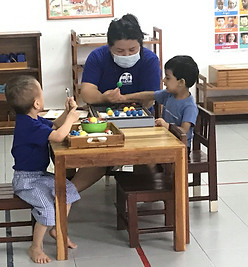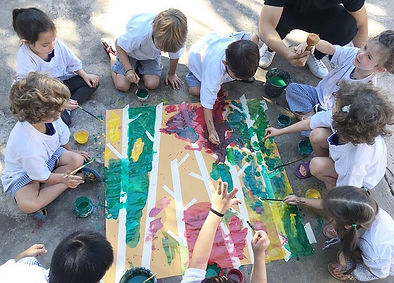
LEARNING AREAS
The Montessori Method is characterized by providing a prepared environment: tidy, pleasing in appearance, simple and real, where each element exists for a reason in order to help in the development of the child. A Montessori classroom integrates children of mixed ages, this promotes socialization, respect and solidarity among them naturally.
The prepared environment offers the child opportunities to commit to interesting and freely chosen work. Children work with concrete materials that were scientifically designed, which provide them the keys to explore our world and develop basic cognitive abilities. The materials are designed to allow the child to recognize the error by him/herself and become responsible for his/her own learning.
The adult is an observer and a guide: he/she helps and stimulates the child with all his/her effort. The curriculum for children from 3 to 6 years old is divided into five working areas: practical life, language, sensorial, science and math.

Sensorial Area
The purpose of sensorial education is to help children refine their senses through the repeated manipulation of specifically designed materials. Children are given a means of classifying and categorizing the world around them. Children will learn to judge different heights, lengths, weights, colours, smells, sounds, shapes, textures, as well as to determine patterns.
Culture and Science Area
The culture and science area covers different subjects, such as geography (land, air, water, maps, continents, people and habits, etc.), science (seasons, senses, earth, experiments, etc.), botany (seeds, plants, trees, nature observation, etc.), zoology (classes of animals and habits, etc.), and history. These subjects are introduced mainly through monthly topics.
Language Area
Santisouk is a bilingual English and Lao school and offers a bilingual curriculum. During their work in the language area or in Casa, children focus first on the phonetic sound of each letter. They learn to connect the sound of a letter to its shape and to familiar objects.
-
Teachers prepare activities to develop language and vocabulary. Activities focus on developing children’s hand-eye coordination and fine-motor skills for writing.
-
Writing precedes reading and it starts with feeling a letter and tracing its shape in sandpaper while saying the sound. When children link sounds and letters, they begin to compose words with the Movable Alphabet. That is the beginning of reading.
Practical Life Area
Activities in this area help children to develop their motor skills, independence, senses, and intellect. Children learn how to care for themselves and the environment around them using real-life materials as much as possible. Children learn how to button and unbutton, zip and unzip, pour, sweep, polish, cut, measure, fold, sort out and many other useful everyday life skills.
Mathematics Area
The first focus for learning is on understanding concepts of size and length (big and small, and long and short), and children are guided to understand concepts of numbers and quantity. They see, feel, match and count. As their confidence increases, they are introduced to the decimal system (up to 1, 10, 100, 1000) using golden beads and other manipulative materials. After they understand the quantities children are introduced to numbers and number symbols (ie. 1, 2, 3)


In addition to the conventional Montessori Learning Areas, we have added others to provide children with a great variety of learning opportunities.

Extracurricular Activities
At Santisouk, children are provided with a variety of extracurricular activities to help reinforce their
developmental needs. Music, dance, yoga, swimming, artistic and physical theme-related fun
activities are offered.
Monthly Theme
Every month a specific topic is selected by the teachers to which activities in casa and Montessori learning areas are linked. The children discuss and explore the monthly theme that includes many hands-on learning experiences.
Please do not hesitate to contact the school if you would like to participate by reading theme-related books you bring from home, sharing experiences or providing a child-friendly presentation.
Outdoor Playground
Santisouk garden is designed to provide children with the opportunity to practice their gross motor skills and social activities in a safe, child-friendly and imaginative environment.
Social-Emotional Skills for
Early Learning
The preschool years are a very important time for children’s development. Every day at school a strong focus is placed on teaching children the skills needed to make and play with friends, to make decisions and express emotions (happiness, anger, sadness, frustration, etc.) with the goal of developing confidence, trust and respect for oneself, others, and the environment.
The program Social-Emotional Skills for Early Learning (SecondStep.org) is implemented at school. It contains a range of teaching guides and materials designed to support students in developing empathy and compassion, to manage their emotions, to make friends and solve problems, and to develop skills for learning. The aim is to help the children to learn self-regulation skills, control their own behavior, and develop social-emotional competencies.

